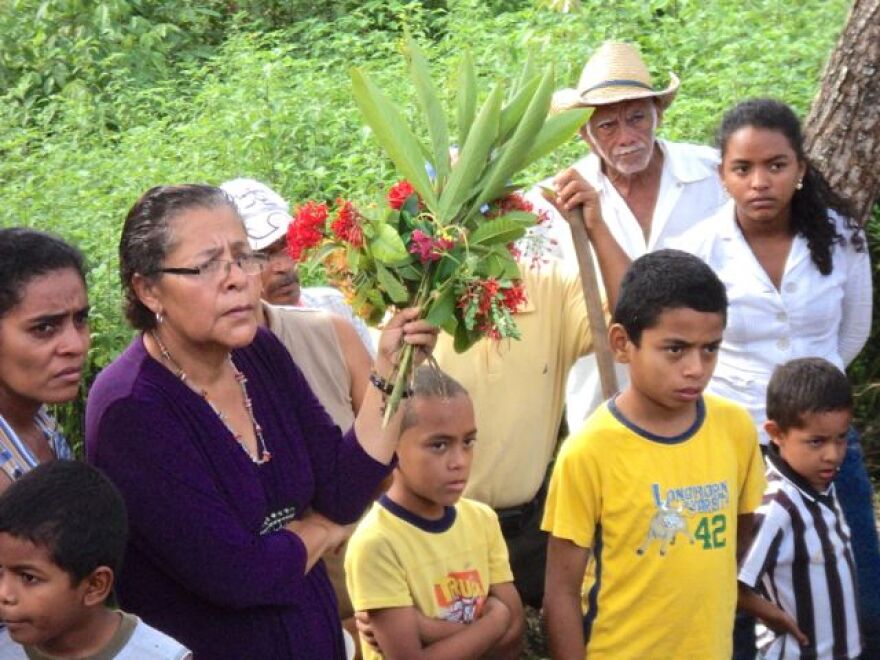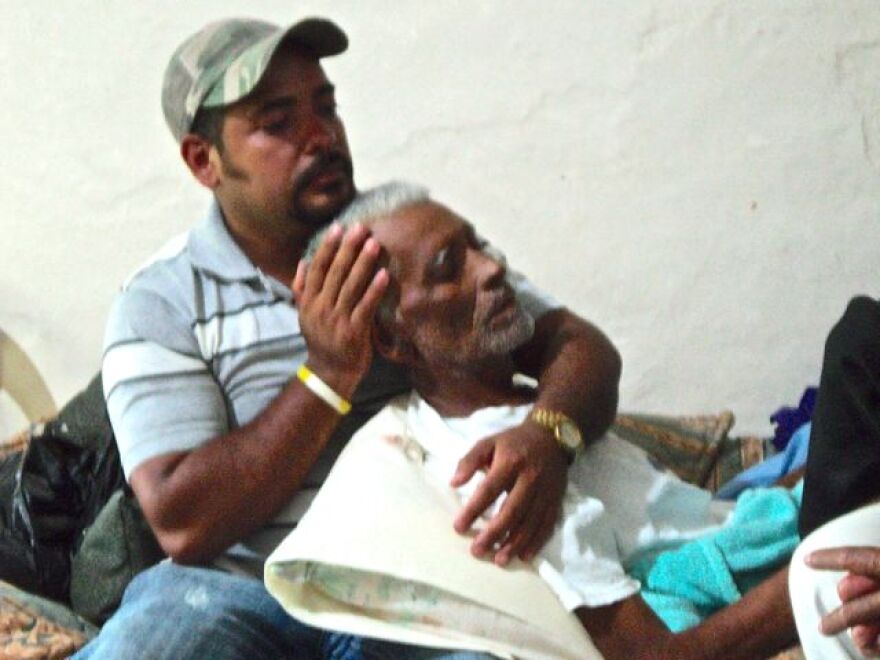This article first appeared in the St. Louis Beacon, Sept. 18, 2013: Monday, Sept. 9, was Chemo’s 19th birthday, but we spent most of the day watching Guillermo die.
His timing was perfect; he lived to celebrate the wedding that Saturday of his son Isaac: big celebration back at the house, full of guests; Guillermo, though bed-ridden, beaming. Out-of-towners left on Sunday, only to get urgent calls early Monday from Erlinda, Guillermo’s wife, that the end was near.
Everybody headed back “home,” some arriving from San Pedro Sula on the late bus about 8:30 p.m., minutes before Guillermo breathed his last and just time for an intense farewell. He died surrounded by most of his 12 children (Dunia lives in Spain), and their children, and in-laws.
Let’s back up a little, because this news must come as a shock after Guillermo’s “miracle” operation for stomach cancer that seemed to set him firmly on the path to full recovery. But follow-up evaluation and treatment were delayed for weeks!
Guillermo was happy as a lark; he even started preaching again on Sundays in Paraiso. When he finally did “check in,” the doctor panicked or something and huge bouts of radiation and then chemo were begun. Were they making up for lost time? No one ever saw a crowded schedule like this, especially for someone supposedly “cancer-free.” Almost 40 days of radiation, tailing into chemo gone wild. Erlinda says they overdosed on the chemo, but she is not blaming anybody. “It was meant to be.” That’s just what my former student, now Dr. Justin Diedrich, told me his grandmother used to say in Yiddish: “b’shert.”
So Guillermo came home too weak to do anything but throw up, as I reported in the last CASA. A brief respite came when I finally found the absurdly expensive “Modifical” that had been prescribed. After just two of the tiniest pills you ever saw, Guillermo’s stomach calmed, he slept 14 hours straight, and awoke with a smile -- and an appetite, ready for the wedding of his son. But I guess it was too little too late.
After the glow of the wedding, the darkness. Erlinda was his -- and our -- light throughout. No hysterics for her, her faith measured in service as she prepared us lunch during the death-watch, and later coffee and rolls. With help, of course. You know how people will say, “If there’s anything I can do....” Well, here, no one asks that question: they just DO.
In his very last moments, such a crowd around Guillermo, all I could see were his toes, twitching little flashes of life, till they finally stilled, like Tom Hanks’ nervous hand in “Saving Private Ryan.” Then the cry went up, a howling and screaming, a couple faintings, desperate hugs, a swirl of bodies. I’m lost in a tumble of thoughts myself, when Erlinda calmly makes her way over to me: “Miguel, we need your chairs.” Duh! I should have thought of that myself! The same chairs I had just loaned for the overflow crowd at the church two days before. (Actually, 11 couples united in that grand Mass.)
As folks settled in for the all-night wake, a celebración was planned, scripture readings, preaching, etc. Again Erlinda: “We’re going to sing, aren’t we? Guillermo had so many songs he loved.” And she started ticking them off by number from the hymnal. Well, Guillermo couldn’t carry a tune, but he did love to sing. Now he’s an angel, in the heavenly choir.
The funeral
The funeral was just as brave, as celebratory as his son’s wedding, thanks mostly to his wife Erlinda. She kept everyone focused on our faith in the Resurrection. “We’re going to sing the whole way to the cemetery.”

There was a huge crowd as we wended our way behind the pickup carrying the casket. When folks started wailing, and even the oldest son fainting dead away, Erlinda stood at the edge of the grave like a Joan of Arc, quietly repeating the meaning of this event: “We all must go the same route, death is part of life, but as Saint Paul teaches us, while we are alive, we live in the Lord, and when we die, we die in the Lord. We are always in God’s hands, and God will not abandon us but raise us up to eternal life.” She just kept talking in a normal tone of voice till all was calm and everyone could hear and understand.
I hope you don’t imagine her a woman in denial, clinging to religion only to assuage unbearable pain. Hers is a strength born of a lifetime of fighting for herself, from the first years of their marriage when Guillermo was an abusive drunk and Erlinda finally learned to stand up for herself. You don’t raise 12 kids -- 6 boys and 6 girls -- by faking it.
She’s an artist, too, a poet, performing her works at public events like graduations. She instilled in her kids a sense of style and presence that makes them attentive to others‘ needs. She opened the path of grace and conversion for Guillermo, who thanked God and his wife with his years of service as a lay pastor in Paraiso.
The next day, a valiant woman, Santos, one of Guillermo’s parishioners, as you might say, died in Paraiso. So two novenarios played out in tandem, 3 p.m. in Paraiso for Santos, 4:30 p.m. in Las Vegas, our “little flock,” as Jesus called his disciples, crossing back and forth across the bridge that connects our villages.
The bridge
Then the bridge collapsed!
Partially, that is. Unrelenting rains and huge floating trunks of trees battered at least one concrete strut off its base and put a big wrinkle in the roadway. Folks ventured across anyway, first on foot, then motorcycles, and finally pickups and cars.
No one wanted to be the first bus or heavy truck to tempt fate, but then they brought in an enormous bulldozer with a shovel attached to pull apart the clog of debris, and nothing happened, no more cracking or collapsing, so I think we’ll be using this bridge a long time yet. After all, this bridge was built in 2005 to replace the bridge that Hurricane Mitch had downed back in 1998.
The celebration
Sept. 15 is Honduras Independence Day, and for the first time Chemo marched in the “peloton,” or formation. A block of 55 students trained and practiced all week under the direction of Profe Fefo, a military veteran himself, who imbues the kids with a sense of discipline and camaraderie.

Now, I heard someone complain, “These are children, not soldiers, they shouldn’t be ‘militarized.’” OK, fair enough, but maybe soldiers should do more marching just for the fun of it, instead of a more dreadful purpose. In thanking Fefo, I teared up, reminding him that we first met when he was even younger than Chemo, and I was just so grateful that someone had enough faith in Chemo that he could accomplish the tricky routines.
We borrowed the long-sleeved shirt from Dora’s son Tito, the dark glasses from her brother Oscar, the necktie was a relic from Pablito and Chepito’s First Communion; we had to buy the “boina,” or cap, and new shiny black shoes. Another nay-sayer says, “See, it’s just commerce, exploiting the poor.” Yes, of course, the poor we have with us always, but for one day, if your child can shine like a star, maybe the future looks brighter.
Miguel Dulick has lived in Las Vegas, Honduras since 2003. There he has no projects, no plans, no investments -- only to share the life of the poor. For years he has been sending reports back to friends and family in St. Louis, and the Beacon is proud to become a part of his circle.

